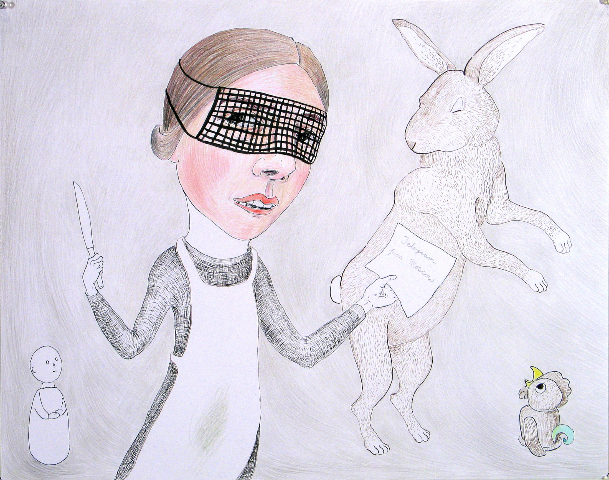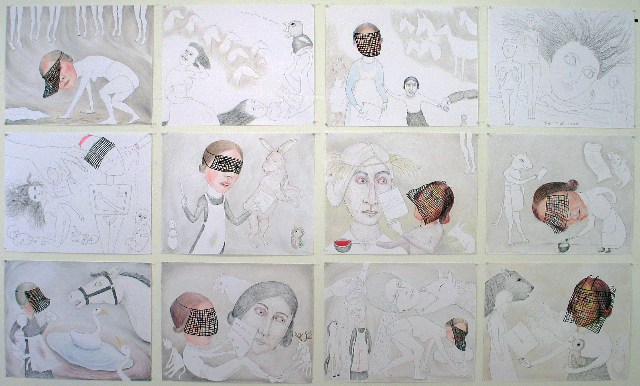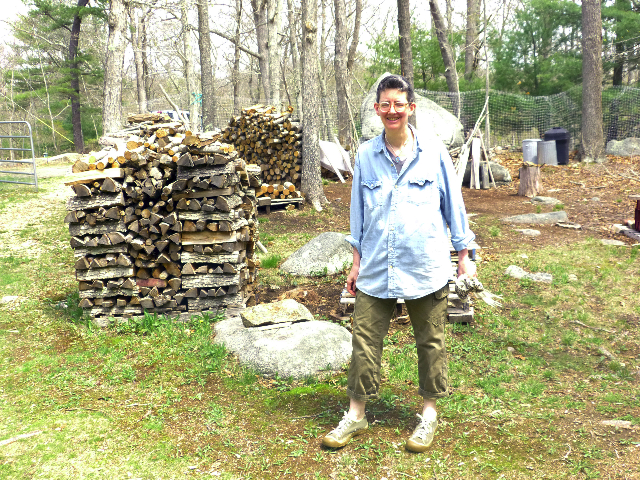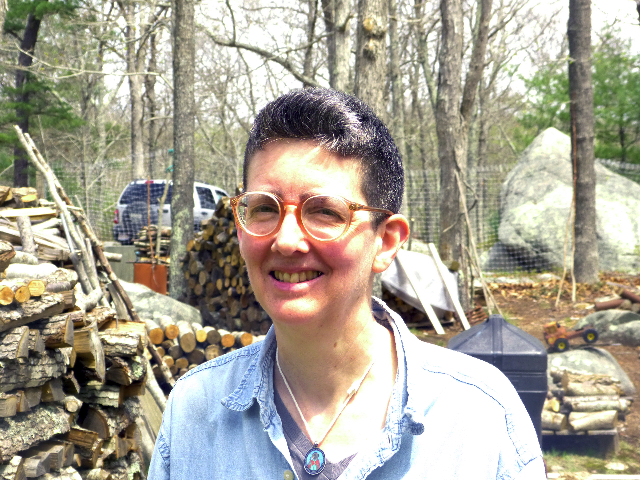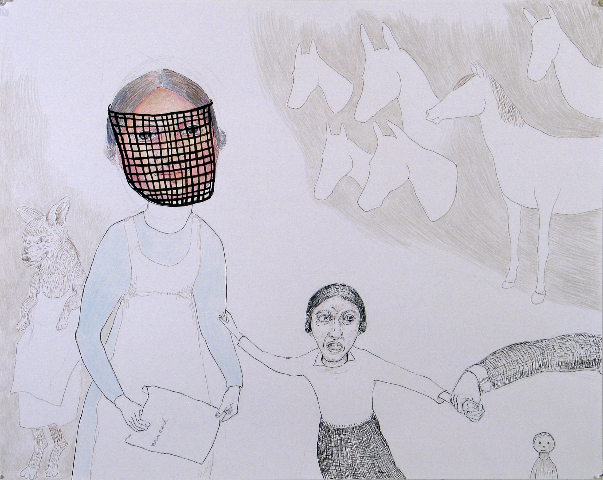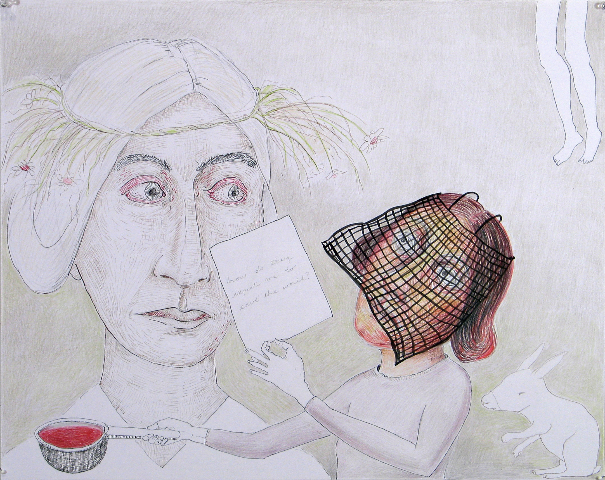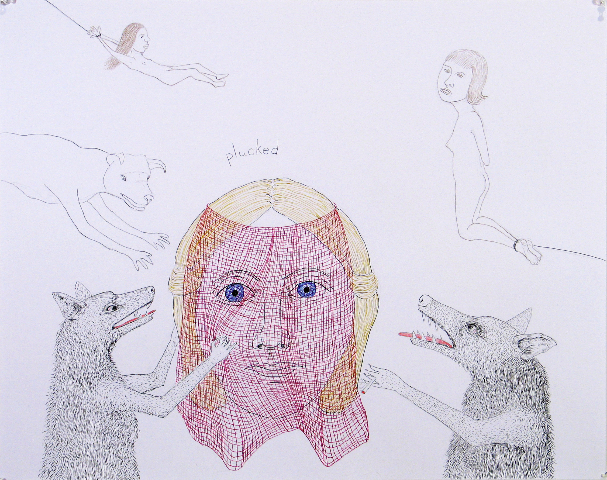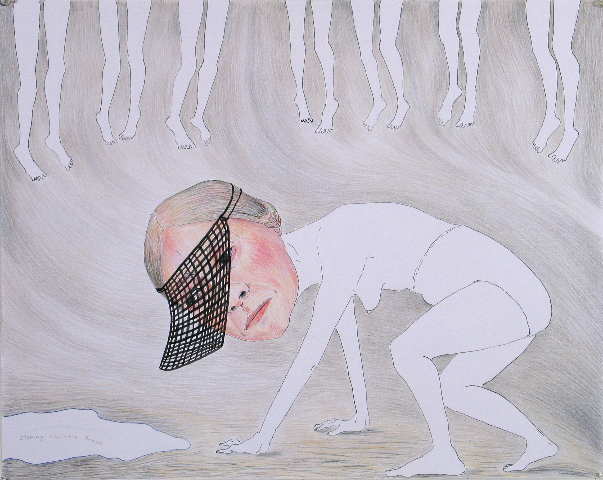Into the Woods with Artist Gabrielle Barzaghi
Hermit of Dogtown Previews Trident Gallery Exhibition
By: Charles Giuliano - May 09, 2017
For decades Gabrielle Barzaghi and I were colleagues at the New England School of Art & Design. I knew her figurative expressionist, large, richly saturated, gestural pastel works through faculty shows and gallery exhibitions.
During a recent week in Gloucester I emailed a request for a studio visit. We negotiated a Saturday morning. With limited interaction over the years there was mutual hesitation.
Some years ago she and her husband, a Gloucester native, bought land deep in the woods of Dogtown Common in the Bayview section of Cape Ann. At the end of the road it provided the kind of privacy and seclusion required by a self described hermit.
She met me at the end of the driveway covered and shrouded as protection from black fly season and ubiquitous ticks. The woodsy guise evoked the image of a refugee which proved to be a theme we discussed during a three hour session in the studio.
Walking to the spacious home and studio they built she revealed reluctance about not welcoming studio visits. "I ask my husband to request a studio visit so I can rehearse ways to politely decline. But we have known each other for so long that I figured what the heck."
Initially there was some awkwardness. That was soon overcome as we engaged in a complex dialogue about the conundrum of work pinned to the wall. Not knowing what to expect I took just a couple of photos and did not record the session.
I suggested that we connect by phone and have another interview. The initial experience allowed for a more focused discussion which has been transcribed below.
Gabrielle Barzaghi I'm having an exhibition Gabrielle Barzaghi: Perfect World at Trident Gallery in Gloucester, Mass. It opens on June 10 and runs through July 9.
Charles Giuliano We have known each other for decades but only recently engaged in a studio dialogue. On the wall were fifteen drawings inspired by Charlotte Bronte which is a part of the coming exhibition. Can you talk about how they evolved?
GB I read a book about her which contained an essay "Stoning Charlotte Bronte." It was written by Anne Baer in "Book Collection" (Summer 2014), and it was her aunt who remembered being visited in Oxford, probably in the 1920s by a very old man who told her that he had once thrown a stone at Charlotte Bronte and hit her.
It was known that Charlotte was hit on the head by a stone. It was thrown by one of her young charges when she was a governess. When she was writing the article a very old man came to her and revealed that he was the culprit.
I was so taken by that and thought why didn't I come up with that title? I love titles and am always trying to come up with a good one.
I started to draw and did perhaps five or six that I started. I had no idea what to do with them. They seemed so dorky that I put them away, Later on a friend came over and I showed them saying "You want to see something really awful?" I said "Isn't this embarrassing?" He said "Yeah, stupid." But, you know what, if it's not really embarrassing and stupid it's not worth doing. I had no idea what I wanted to do.
Then later, with the election campaigning going on, I pulled them out. I took one out and drew a grid over the face. With no planning it just launched into this thing. I was so disturbed by what was going on in the world. I ended up taking a phrase from one of my grandmother's recipes "Not Enough." That launched me into this. I drew a piece of paper that this figure was holding very awkwardly. It took me a long time to figure out what I was going to do. Finally I wrote on it "Not Enough." I kept going with it and they're allegories. They're filled with physical and formal eccentricities and I wanted that.
That's how I was able to enter this personal and political world. It reflects what I was feeling about the state of the world.
When I started working on this show I wanted to call it "Hallucinations." I started a series of pastels that were hallucinatory. But then the whole world became hallucinatory. I shifted my focus more to what was going on. It wasn't so much about Charlotte but the phrase "Stoning Charlotte Bronte" was a metaphor.
Listening to President Trump I was wondering "What will be do next? Stone Charlotte?" He was slinging insults, threatening and bullying. He was calling women dogs, assaulting them and bragging about it. I was filled with rage at the xenophobia. I am the granddaughter of refugees. I grew up with a refugee in my house. All this abuse is going on as well as sex trafficking.
There is a whole peculiar way of doing these drawings. They aren't "macho" drawings. When you walked in and Matt (Swift of Trident Gallery) walked in you really didn't want to look at it. They're very subtle. Charlotte really morphed into my grandmother. I was thinking about war, refugees, the witch trials, destruction of our planet. I added some absurdist humor. That's Russian and I grew up with that. I like absurdist literature.
CG Can we go back to the idea of stupid, how the work is difficult, and off putting? How is stupidity and awkwardness a matrix for a dead end or a launch point? How do the negatives lead to the positive of motivating and sustaining the development of the series? Is it a stimulus or an impasse?
BG If you start something and it looks like a million bucks right away, you think, oh. The whole thing of doing things that are embarrassing. A couple of people have said to me, oh God, it's so embarrassing. That's a good thing. It's not that this is so unique. You could find lots of stuff that looks just like this. But they are awkward and for me I really had to feel my way through it. I hated it but then I loved it. Every day I just sat there and said I'm going to do this. I started with what I had started so I already had something down. I started free associating. I went into this place. Some of it was stories from Russia that I had been told. Other ones were from my imagination. I have a big picture file and took images from that.
CG You comment on studying the reactions and lack of initial responses when Matt and I first walked into your studio. Was perhaps a part of that how a male might view the work differently and less sympathetically than a female viewer? Is there a gender issue regarding responses to the work?
GB I don't know. It depends. Guys who like to draw and do figurative work, maybe will find it interesting because they are interesting drawings. I wanted them to be working formally. Aside from the subject matter there's a formal way in which it's done. I wanted that to be interesting. I don't want to make a sweeping generalization.
CG You used the work macho.
GB I make "macho" work. It's big. There's a lot of color and contrast. I draw with my whole arm. I grab people. They're macho for me. But these drawings are very delicate. They probably are more female. I kept saying "Are these too girly?" God forbid I do girly work. (both laugh)
They're nasty. It's a nasty, nasty subject. I thought "How am I going to do this?" It's not bright, bright color with a lot of contrast. I wanted them to be serene. There's writing on them which I normally never do. That felt very important. There was a time of despair when I had no idea of what I wanted to do. I drew myself naked lying on my back. I just made it up. Today I did nothing. It doesn't look like me. It's just a female figure. On top of me is a chicken saying "His prim righteous face surrounded." It can mean what you want it to mean. His face is surrounded by people about to strangle him. Or maybe he's surrounded by the religious right. The main thing is "prim and righteous." The drawings have come from repeated imagery with a monster face and Greek head.
CG What does Charlotte Bronte mean to you? If you are evoking her then Charlotte is a feminist icon. One thinks of Jane Eyre and the Bronte sisters, Charlotte, Emily and Ann. They were among the first women to publish under their own names during their lifetime. Jane Austen's works were published posthumously. They were among the first women to make a living through literature. They were independent women and pioneers. It was a turning point for women in the arts. Talk about her as an icon as well as the metaphor of a terrible assault, the rock thrown at her head.
GB Art is impossible to really understand. When It's working it's a visual thing. It's not intellectual. I didn't start by thinking, I revere Charlotte Bronte, and she's this icon. I wasn't thinking about that. I had read all of her works. I read Jane Eyre when I was in 7th grade. It's a metaphor and allegory. I latched onto that because I had just read this book and was attracted to the phrase. She's the epitome of innocence. She got bonked on the head. Everybody has. My brother whacked me on the head. I still have the scar. He hit me on the head with a rock. It happens. I was attracted to the poetic element of the phrase and what it implied. I went with that. I started out with the idea of focusing on using that phrase. But it really didn't go anywhere. I couldn't move forward with it. It moved forward as a commentary of what's been going on. And not just to women.
CG You have described this work as different from what I am more familiar with. It is more delicate, linear and incisive. You described a process of erasing and eliminating.
GB I don't just do pastel. In the past I have done other work. I work in a number of mediums but hadn't done any ink work. I don't know what possessed me. I had a piece of paper and thought it would be good for ink and just started to draw on it. There's nothing more complicated than that. If it feels appealing at the moment I'll do it. They started as pencil drawings but I hate colored pencil. It started out that everything was wrong. I hate colored pencil. But what else was I going to use? I used ink and a brush then I got out my dip pen. I didn't use markers. Everyone uses markers. The pen you dip in ink is very old fashioned. I sketched with pencil then erased and adjusted working out the composition. Then I drew with ink creating these linear drawings. They're very subtle. I used brown and black ink. Also I worked with different pens and finer points. As I went I figured it out. Then I decided they were too white and toned the background with colored pencil. They looked very pale and I thought, oh God, ick. The alternative was making them darker but I didn't want that either. It was a matter of getting used to the way they looked.
CG What time frame are we talking about? How much did each one take and how did the series evolve?
GB Over a couple of months I worked on them intensively. It was very tiring so I had to take breaks. Once it's down you can't erase so you really have to think about what you want to do. Not including break time they took a day and a half each. Some I went back and worked on some more. Making them darker or adding more color. I did that because I wasn't satisfied with some of them. Later on I went back and did three more. I hadn't worked with this medium so that was a departure for me. I fool around and do stuff but I had never done any finished drawings like this. I don't write on my work so that was something new.
As depressing as they were I found them hilariously funny. It was very entertaining. I don't think of myself as a political artist. I guess they are because they are a response to what's going on. It was very hard to ignore but how do you respond to it? Do you keep doing your work and not address it? As much as I had doubts I just kept doing them. I just do it and another and another. It was very absorbing. I ended up with 15 of them. There they are and God help us. My show is coming up. This is what I have and they're going in. (both laughing). There's a lot of pressure. To make 15 drawings that satisfy is a very hard thing to do.
CG You had several drawings in the recent Trident Gallery exhibition on the theme of The Body Politic. Speaking with Matt and his wife Sarah Slifer Swift, a dancer, they described that the idea originated with some NY based dancers they invited to perform in the gallery. Matt curated the fine art component including the work of Gloucester artists. For the most part the work was oblique and thought provoking. In that context your work was more specific and direct in response to Trump. In my review, as well as a discussion over dinner, I tried to articulate my ideas about the new and old agit-prop. For me it works best when not in my face. In that sense Apocalypse Now was a more significant and lingering statement about Vietnam than Platoon which was explicit. It is the contrast of agit-prop expressed poetically vs. as strident propaganda. The current situation is inspiring a lot of politically motivated work. There has been a lot of debate about the current Whitney Biennial. How do you see yourself in that dialogue?
GB I never expected to show those drawings. I did them because I was so mad. We had a panel discussion in the gallery and Sarah asked me how they related to political cartoons. Actually I was horrified at the idea that I was doing political cartoons. Because I really don't think about that. They're in pen and ink so everyone thinks cartoons or a children's book. I was just so mad. I grew up doing insulting drawings of people. (laughing). During the panel I asked "Doesn't everyone grow up doing insulting drawings of people?" They all said "No, when we did that they ended up on the kitchen door." They weren't mean. They were funny. When I did those drawings in Body Politic I was so disturbed and angry. The things he (Trump) said were so awful. I used what he said as titles. I looked forward to the news every day. What did he say that I could use? I wanted them to work as drawings. The idea of misogyny goes way back. That was nothing new. The whole thing I said about stoning Charlotte, well, why not? With all this other stuff that will be next. I used figures from art history. There is a fertility goddess. I wanted them to trans historical.
CG You also used Cycladic figures.
GB That's right. There's some of those in this piece (Stoning Charlotte Bronte). I wanted to be functioning on another level. I don't know how to do that. I'm not a political cartoonist. For me first and foremost they were drawings.
When Matt was doing the show he wanted that huge pastel with three heads. I said I also have these drawings, "Do you want one?" He took all of them.
CG The most graphic element of this series is the use of a grid over Charlotte's face. It could be a veil or protection like a fencer's mask. How did that come about?
GB At first it was just a formal element. I thought this is so ugly. I've got to cover it up. Why don't I draw a veil. I do that in my work where I draw something and then I draw something on top of it. That's something I often do. It's something that's so unsuccessful that you cover it up. Right? I did that and it was so bizarre and strange. I liked the way it looked formally. There's symbolism that goes along with it. I didn't want it to be this Muslim thing. But it was a kind of barrier or mask. I liked it formally so I kept using it. I thought it was comical. I didn't draw them to look like veils. A couple of them look like that but they're very awkward.
You do these things and there isn't, for me, a big intellectual thing. It gets revealed as I'm going. I don't know what people will think. Matt says "You're so esoteric." But I think it's obvious. Nobody gets it but it doesn't really matter because I'm entertaining myself and you can read it at any level you wish.
CG The expression on Charlotte's face is very anxious.
GB Yeah, that's an ugly picture with the hanging legs. I had been reading about the Salem Witch Trials and yes, it's a disturbing image.

